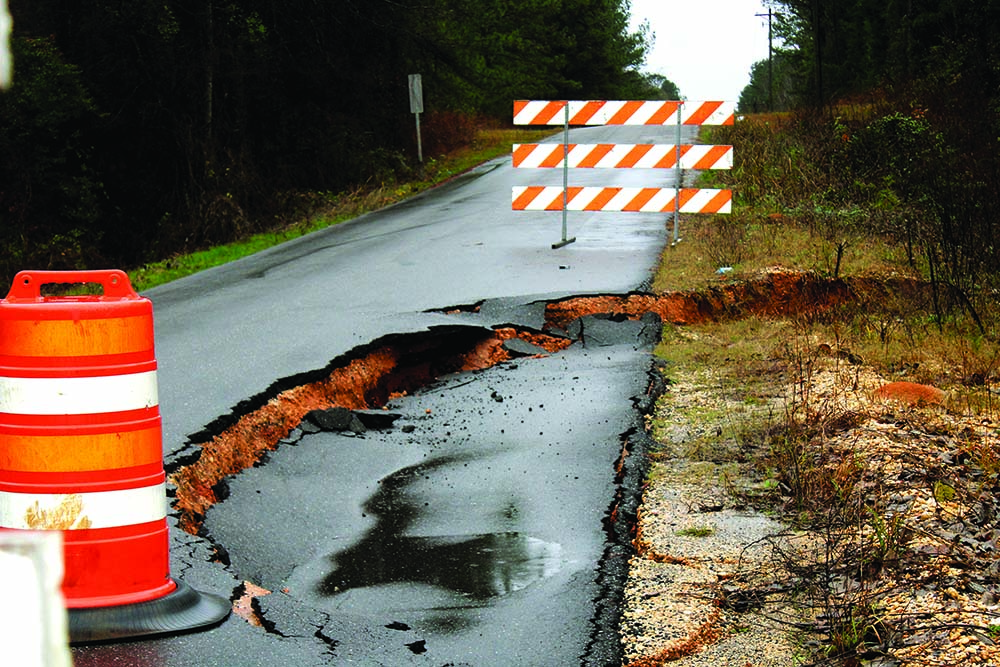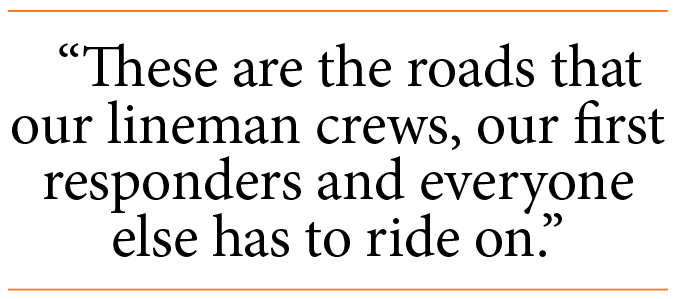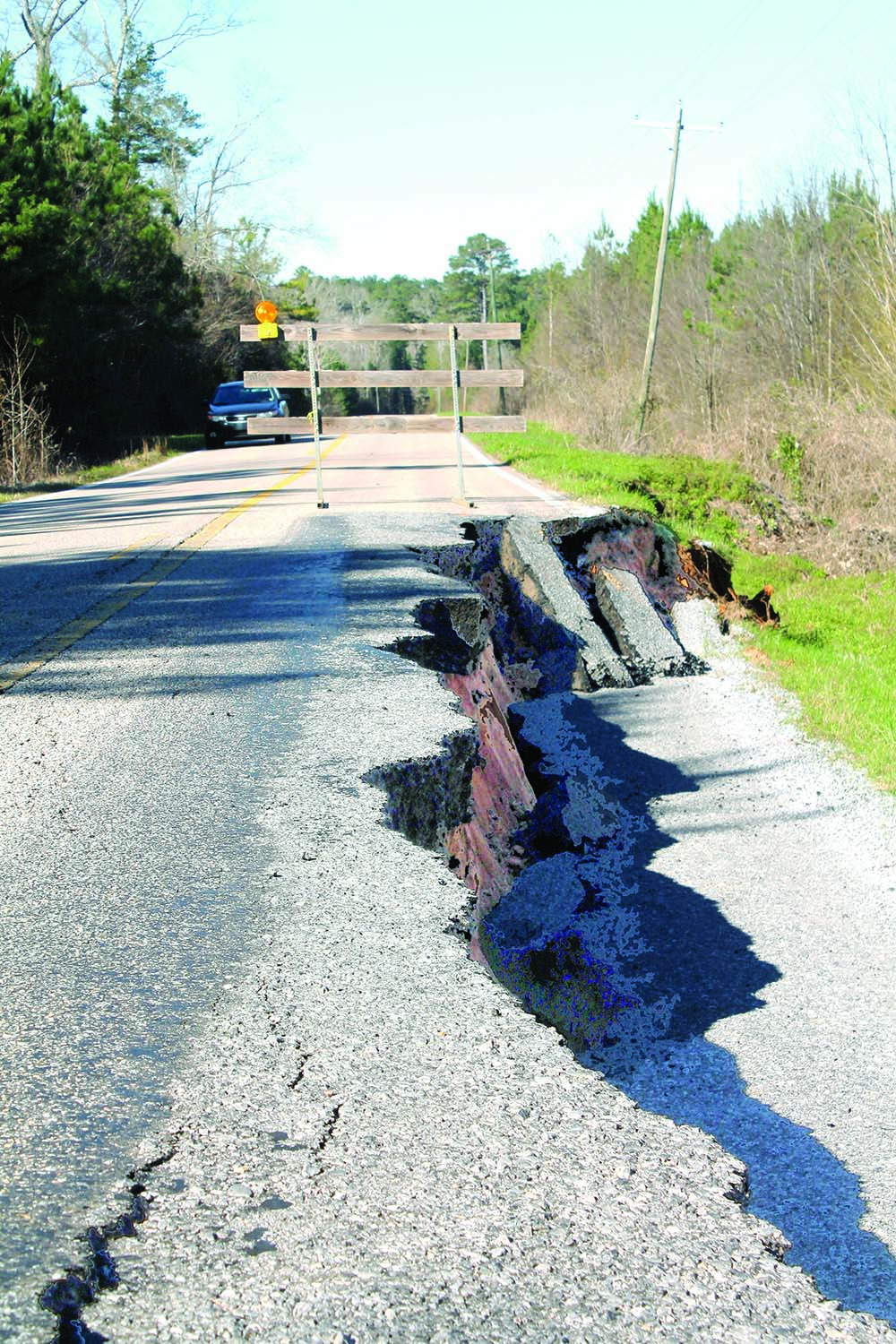
By Minnie Lamberth
Daryl Jones, general manager of Black Warrior EMC in west Alabama, is very familiar with the conditions of the roads in Alabama’s rural areas. Black Warrior has a service area that touches 12 counties. “We travel over about 7,000 miles of county roads,” Jones says. “On any day we will have about 35 to 40 company vehicles on those roads.”
Over his 35 years at the co-op, he’s noticed that conditions have gotten worse. “Most of the county roads we see need a lot of work,” Jones says. “We don’t see a lot of widening of the existing roads. We don’t see county dirt roads being paved.”
 He also noted that culverts need replacement. Flooding after heavy rains can be too much for them to handle. “When those culverts blow out, we have members who are stranded.”
He also noted that culverts need replacement. Flooding after heavy rains can be too much for them to handle. “When those culverts blow out, we have members who are stranded.”
Though some counties where the co-op serves have their own county gas tax, Jones can tell the difference in areas that don’t. “What you see is they’re struggling to continue maintenance on what they have,” he says.
Roads across the state will get much needed attention if the Alabama legislature acts on proposals coming their way in the next session, which begins on March 5.
In her inaugural address on Jan. 14, Gov. Kay Ivey called for additional investment in the state’s infrastructure, including the state’s roads and bridges. This added funding would come through an increase in the gasoline tax.
“Obviously we need more revenue,” says Tim Culpepper, general manager at Cullman Electric Cooperative in northwest Alabama. “Our rural farm to market roads are falling apart.”
The roads and trails around Smith Lake in Cullman County in particular are always impacted by heavy rain and extreme weather conditions, he adds. “These are the roads that our lineman crews, our first responders and everyone else has to ride on.”
Steve Sheffield, general manager at Clarke-Washington EMC, says his area has similar needs. “We serve some of the most rural and distressed areas in the state in Clarke, Washington, Wilcox and Monroe counties. I believe the counties have done the best job they could with the available funding but there are still many rural roads that are in dire need of attention,” he says.
In addition, Sheffield notes, “US Highway 43 desperately needs a turn lane between Jackson and Grove Hill and US Highway 84 is four lane to our west and east, but is a heavily traveled two lane through our service area.”
As Ivey noted, it’s been nearly three decades since the legislature has provided any change in funding for road improvements. The most recent gas tax legislation passed in 1991, and those who understand the conditions of the state’s roadways are welcoming the prospect of additional resources. These groups include the Association of County Commissions of Alabama.
“We’re falling behind. Not only can we not catch up, we’re actually losing ground,” says Chase Cobb, ACCA’s governmental affairs manager.

Cobb specifically highlighted county roads – which are largely dependent on the state’s gas tax for maintenance and resurfacing. Cities have more flexibility to pass a revenue measure such as a sales tax. County governments, however, must have legislative approval even if a gas tax increase is proposed at the local level.
In 2018, the ACCA released results from a road and bridge data collection survey that provided a picture of county infrastructure across the state. Of 44,790 paved county roads that currently exist, 48% have been resurfaced over the last 18 years, the survey showed. However, the national standard for road maintenance is to resurface every 15 years.
“Counties aim for a 15-year road cycle,” Cobb says. “It’s cheaper to maintain a road than it is to have to rebuild it. In 18 years, we should definitely have resurfaced all of our roads. We’re only halfway there.”
It’s not likely that the state is catching up anytime soon. Cobb adds, “In the next five years, we’re only projected to resurface 8%.”
County bridges are facing a similar situation. Of the 8,663 bridges on county roads, 45% are 50 years old or older – and at a timeframe for replacement or rehabilitation. However, only 4% of bridges are projected to be replaced over the next five years.
What is the cost of doing nothing? As Ivey said in her address, “Improving our infrastructure is more than an investment in our roads and bridges; it’s an investment in economic development, public safety and local communities.”

The conditions of county roads impact economic development because industrial sites are often in the county. “Without proper infrastructure, it becomes difficult to attract industry,” Cobb says. Safety issues are also created. Revenue for roadways is used for striping, signage, herbicide treatment and other forms of routine maintenance, including mowing rights of way.
“The maintenance budget takes up so much money we don’t have money left over for resurfacing,” Cobb says.
As legislation is proposed and debated, one of the big discussion points will be in how the funds are split among localities. Recognizing that city governments and county governments will both be seeking funds from the same source, Jones hopes the division will be fair. “They need to come out with a plan that’s prorated fairly,” Jones says.




